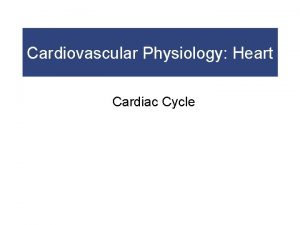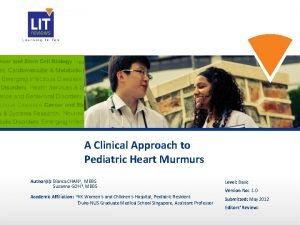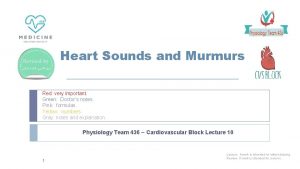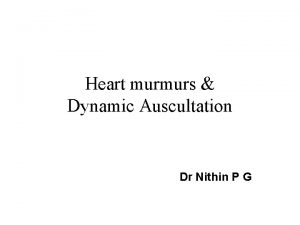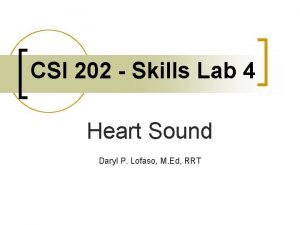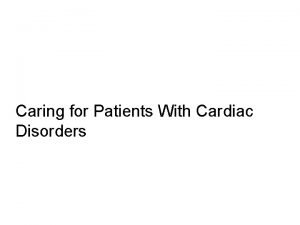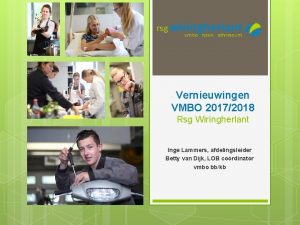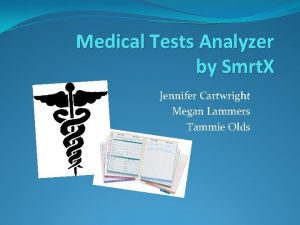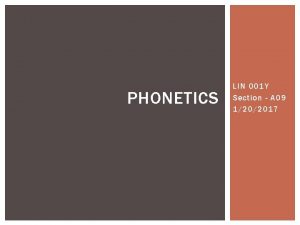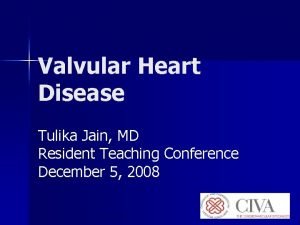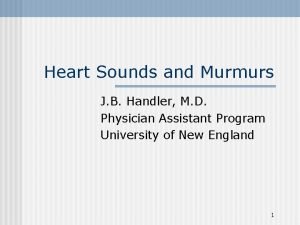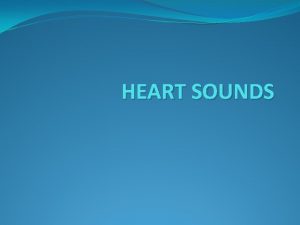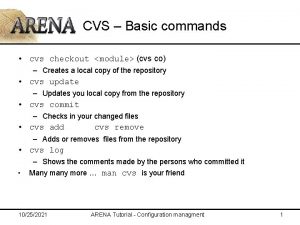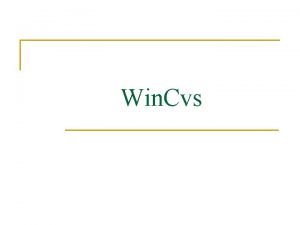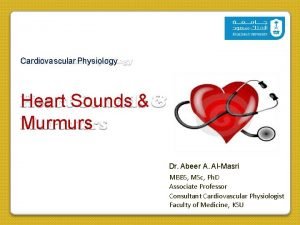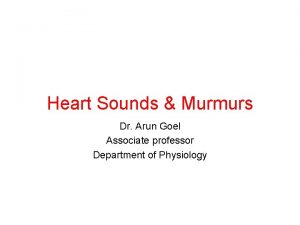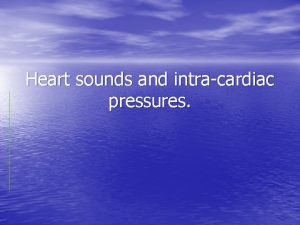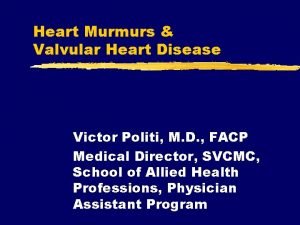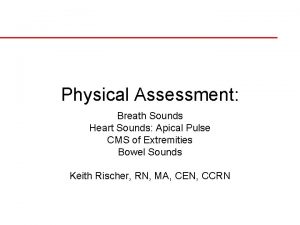Heart sounds and murmurs Prof Lammers CVS module















- Slides: 15

Heart sounds and murmurs Prof. Lammers CVS module/ week 2 Medical Presentations http: //hastaneciyiz. blogspot. com

Function of the valves w Valves prevent the back flow of blood. w The papillary muscles will not close the valves, they will maintain the closure of the valves. w The importance of chordea tendinei attached to the papillary muscles is because during ventricular contraction the ventricle size decreases and the papillary muscle must contract to shorten the chordea tendinei to prevent the leakage of valves

Heart sounds w Listing by a stethoscope to the heart sound we can hear: w Lub (first heart sound) which is associated with the closure of the AV valves w Dub (second heart sound) which is associated with the closure of the semilunar valves

Heart sounds

Cause of the heart sounds w Slapping of the valves leaflets is not enough to generate a heart sound. w The causes of the 1 st heart sound: n n During systole the AV valves are closed & blood tries to flow back to the atrium back bulging the AV valves. But the taut chordae tendinae stop the back bulging and causes the blood to flow forward. This will cause vibration of the valves, blood & the walls of the ventricles which is presented as the 1 st heart sound.

Cause of the heart sounds w The causes of the 2 nd heart sound: n n During diastole, blood in the blood vessels tried to flow back to the ventricles cause the semilunar valves to bulge. But the elastic recoil of the arteries cause the blood to bounce forward which will vibrate the blood the valves and the ventricle walls. This is presented as the 2 nd heart sound.

Difference between the nd 2 heart sounds st 1 and w The 1 st sound lasts longer because the AV valves are less taut than the semilunar valves which will enable them to vibrate for longer time. w The 2 nd heart sound had higher frequency due to n n The semilunar valves are more taut The great elastic coefficient of the taut arteries which provides the principle vibrations of the 2 nd heart sound.

Other heart sounds w The 3 rd heart sound: is the heard in the mid diastole due to the blood that fills the ventricles. w The 4 th heart sound: also known as atrial heart sound. It occur when the atrium contracts & pumps blood to the ventricles. This sound is almost never heard by the stethoscope.

Where can we hear the sound? n n Tricuspid valve: is best heard at the Rt half the lower end of the sternum body Mitral valve: is best heard at the Apex of the heart (Lt 5 th intercostal space at the midclavicular line) Pulmonary valves: is best heard at the Lt medial 2 nd intercostal space Aortic valve : is best heard in the medial 2 nd Rt inetercostal space.

Where can we hear the sound

Heart murmurs caused by valvular lesions w Murmurs of the aortic stenosis In aortic stenosis, there is narrowing of the aorta resistance to ejection of blood As a result severe turbulence of blood at the root of the aorta intense vibration loud systemic murmur ( after 1 st heart sound).

Heart murmurs caused by valvular lesions w Murmur of the aortic regurgitation: In aortic regurgitation, the aortic valves doesn’t close which is essential during diastole. Therefore in aortic regurgitation blood backflow in the ventricles causing diastolic murmurs (after the 2 nd heart sound).

Heart murmurs caused by valvular lesions w Murmurs of Mitral stenosis In mitral stenosis there is narrowing of the mitral valve increase resistance of blood flow to the ventricles. After 1/3 of diastole when enough blood fills the ventricle, it causes vibration which present as diastolic murmur. The murmur is often not heard but could be felt as thrill at the apex of the heart.

Heart murmurs caused by valvular lesions w Murmurs of Mitral regurgitation In Mitral regurgitation the Mitral valves are unable to close which is essential during systole therefore blood flows back to the atrium causing a systolic murmur.

Heart murmurs caused by valvular lesions w Machinery murmur of patent ductus arteriosis In PDA blood flows from the aorta to the pulmonary artery murmur during systole and diastole. The murmurs during systole is much more tense than in diastole because the pressure in aorta is higher during systole than diastole. Medical Presentations http: //hastaneciyiz. blogspot. com
